Matthew 26
Matthew 26 is the 26th chapter of the Gospel of Matthew, part of the New Testament. This chapter covers the beginning of the passion narrative, which continues to chapter 28, containing the narratives of the Jewish leaders' plot to kill Jesus, Judas Iscariot's agreement to betray Jesus to Caiphas, the Last Supper with the Twelve apostles and institution of the Eucharist,[1] the agony in the garden of Gethsemane and the subsequent vindication of Jesus' predictions that one of the twelve will betray him and that he will be disowned by Peter.[2]
| Matthew 26 | |
|---|---|
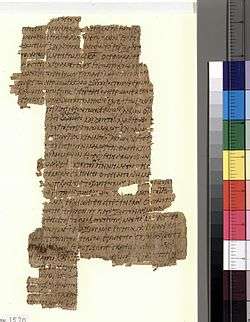 Gospel of Matthew 26:19-37 on the recto side of Papyrus 37, from c. AD. 260. | |
| Book | Gospel of Matthew |
| Category | Gospel |
| Christian Bible part | New Testament |
| Order in the Christian part | 1 |
| Gospel of Matthew |
|---|
|
Chapters |
Text
The original text was written in Koine Greek. This chapter is divided into 75 verses, more than any other chapter in this gospel. Protestant theologian Heinrich Meyer identifies 32 verses in which there are critical variations between different early manuscripts and critical editions.[3]
Textual witnesses
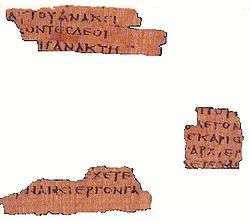
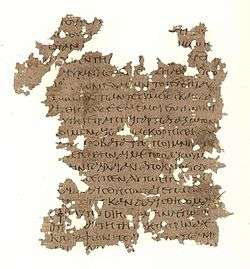
Some early manuscripts containing the text of this chapter are:
- Papyrus 64 (Magdalen Papyrus) (~50-70; extant: verses 7-8, 10, 14-15)
- Papyrus 37 (~260; extant verses 19-37)
- Papyrus 53 (3rd century; extant verses 29-35)
- Codex Vaticanus (325-350)
- Codex Sinaiticus (330-360)
- Codex Bezae (c. 400)
- Codex Washingtonianus (c. 400)
- Codex Ephraemi Rescriptus (c. 450)
- Codex Purpureus Rossanensis (6th century)
- Codex Petropolitanus Purpureus (6th century; extant verses 58-64)
Old Testament references
Structure
The New King James Version organises the chapter as follows:
- The Plot to Kill Jesus (Matthew 26:1–5)
- The Anointing at Bethany (Matthew 26:6–13)
- Judas Agrees to Betray Jesus (Matthew 26:14–16)
- Jesus Celebrates Passover with His Disciples (Matthew 26:17–25)
- Jesus Institutes the Lord’s Supper (Matthew 26:26–30)
- Jesus Predicts Peter’s Denial (Matthew 26:31–35)
- The Prayer in the Garden (Matthew 26:36–46)
- Betrayal and Arrest in Gethsemane (Matthew 26:47–56)
- Jesus Faces the Sanhedrin (Matthew 26:57–68)
- Peter Denies Jesus, and Weeps Bitterly (Matthew 26:69–75)
Prologue to the passion narrative (26:1–5)
Verses 1-5 recount the conspiracy against Jesus.[5] Meyer, reflecting the opinion of theologian Johannes Wichelhaus, notes "the fact that our Lord’s functions as a teacher were now ended".[3]
Verse 2
- "You know that the Passover takes place after two days, and the Son of Man will be handed over to be crucified."[6]
- "After two days": The Jewish feast of the Passover began on the 15th of the month of Nisan. Matthew begins his narrative of the betrayal and death of Jesus two days before the Passover, i.e. on the 13th of Nisan. This may allude to the traditions related to the binding of Isaac that Genesis 22:4 places the sacrifice of Isaac on the third day, and during Passover (in Jubilees 17:15; 18:3).[1] A further parallel between Jesus and Isaac is indicated in Romans 8:32, whereas Matthew 26:36 could allude to Genesis 22:2-5.[1]
The Anointing at Bethany (26:6–13)
In the home of Simon the Leper, 'another befriended outcast', a woman performed an 'extravagant act' which clearly points to Jesus' messianic status as 'the anointed one'.[1] In verse 8, the disciples, collectively, raise concerns about the extravagance shown, whereas in John 12:4 this concern is only expressed by Judas Iscariot. Meyer argues that Matthew's account is "certainly not contradictory [to] that of John, but only less precise".[3]
Judas agrees to betray Jesus (26:14–16)
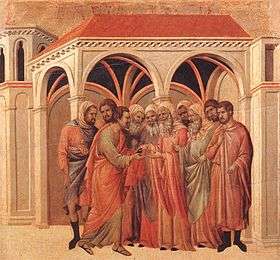
In contrast to the extravagant act of the woman who anoints Jesus, Judas Iscariot (cf. Matthew 10:4) plans a treacherous act, giving a clear distinction of selfless costly gift of what the woman has with the selfish thought for Judas' own gain albeit for a 'relatively paltry sum'.[1] Here, Judas becomes an example of Jesus' followers who think of what they can get out of him, rather than how they can serve him.[7]
Jesus celebrates Passover with His disciples (26:17–35)
As a law-observant Jew, Jesus celebrates his last Passover within Jerusalem, when he institutes the Lord's supper, to connect his sacrificial redemptive act with the 'blood of the covenant' in Exodus 24:8 and Jeremiah 31:31 and the suffering servant of Isaiah.[1]
Agony in the Gethsemane (26:36-46)
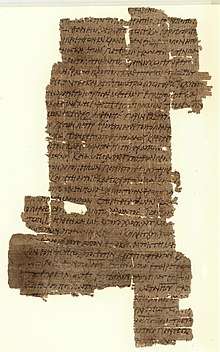
Jesus seems to recoil from the impending crucifixion, but he fixes his course to the will of God and 'this overrides whatever feelings he has about death'.[8] The submission to the divine will: "Thy will be done" (verse 42; also in verse 39), alludes to the Lord's Prayer, as do the address "my Father" (verse 39) and the words "that you may not come into the time of trial" (KJV: "enter not into temptation"; verse 41).[8] The garden of Gethsemane is located on the Mount of Olives, where king David once prayed for deliverance from a betrayer (2 Samuel 15:30-31), and a suitable site for his descendant, Jesus, to utter an analogous prayer.[9]
Betrayal and arrest in Gethsemane (26:47–56)
The story of Jesus' arrest involves many people, pulling together 'several strands from previous sections', with Jewish leader plotting to take Jesus 'by stealth and avoid a riot (verse 4; cf. verse 16), Judas' betrayal as Jesus has foretold (verse 21, 25 and 45), the crowd of 'chief priests and the elders of the people (verses 3-5, 14-16) as well as Jesus' predictions of his sufferings.[10]
Jesus faces the Sanhedrin (26:57–68)
The trial shows that Jesus is not a 'victim of tragic, impersonal circumstances' nor a 'casualty of the ordinary machinery of justice', but a target of attack by wicked people.[8] His enemies 'speak falsehoods (verse 59–60), accuse him of blasphemy (verse 65), condemn him to death (verse 66), viciously hit and mock him (verses 67–68)'.[8] In contrast, Jesus' identity becomes clear as the Messiah and Son of God, who builds the temple (cf. 2 Samuel 7:14), sits at God's right hand (Psalm 110:1) and 'the suffering servant of Isaiah 50:6 whose face is spat upon'.[11]
Peter denies Jesus, and weeps bitterly (26:69–75)
In the early part of this chapter, Judas defects, then the disciples flee when Jesus was arrested, and now Peter, despite his promise (verse 35), denies that he knows Jesus, forming a 'climax of the disciples' failure'.[12] This passage supplies an ironical balance, when Jesus' prophetic powers are mocked, while the literal fulfillment of his detailed prediction about Peter is precisely taking place.[12] Another balance is in the trial, as Jesus and Peter both faces three sets of accusers—Jesus faces false witnesses in verse 60, the two witnesses in verses 61-62, Caiaphas verses 63-66, while Peter, not far away, also faces three different persons confronting him about Jesus.[12] The gospel of Matthew does not idealize any disciples, but instead, 'presents them as completely human', just as the bible of the community at that time (Old Testament) does not hide Noah, Moses, David nor Solomon from the records of their sins.[12] Dale Allison notes that "God can use ordinary people for his extraordinary purposes and, when they fall into sin, he can grant them forgiveness."[12]
See also
- Holy week
- Thirty pieces of silver
- Related Bible parts: Psalm 41, Mark 14, Luke 7, Luke 22; John 12, 13, 18; 1 Corinthians 11
References
- Allison 2007, p. 879.
- Allison 2007, pp. 880-882.
- Meyer, H. A. W., Meyer's NT Commentary on Matthew 26, accessed 16 October 2019
- Kirkpatrick, A. F. (1901). The Book of Psalms: with Introduction and Notes. The Cambridge Bible for Schools and Colleges. Book IV and V: Psalms XC-CL. Cambridge: At the University Press. p. 838. Retrieved February 28, 2019.
- Jerusalem Bible (1966), sub-heading at Matthew 26:1-5
- Matthew 26:2 HCSB
- Keener 1999, p. 620.
- Allison 2007, p. 880.
- Keener 1999, p. 634.
- Allison 2007, pp. 880-881.
- Allison 2007, p. 881.
- Allison 2007, p. 882.
Source
- Allison, Jr., Dale C. (2007). "57. Matthew". In Barton, John; Muddiman, John (eds.). The Oxford Bible Commentary (first (paperback) ed.). Oxford University Press. pp. 844–886. ISBN 978-0199277186. Retrieved February 6, 2019.
- Keener, Craig S. (1999). A Commentary on the Gospel of Matthew. Wm. B. Eerdmans Publishing. ISBN 978-0-8028-3821-6.
External links
| Wikimedia Commons has media related to Gospel of Matthew - Chapter 26. |
- Matthew 26 King James Bible - Wikisource
- English Translation with Parallel Latin Vulgate
- Online Bible at GospelHall.org (ESV, KJV, Darby, American Standard Version, Bible in Basic English)
- Multiple bible versions at Bible Gateway (NKJV, NIV, NRSV etc.)
| Preceded by Matthew 25 |
Chapters of the New Testament Gospel of Matthew |
Succeeded by Matthew 27 |